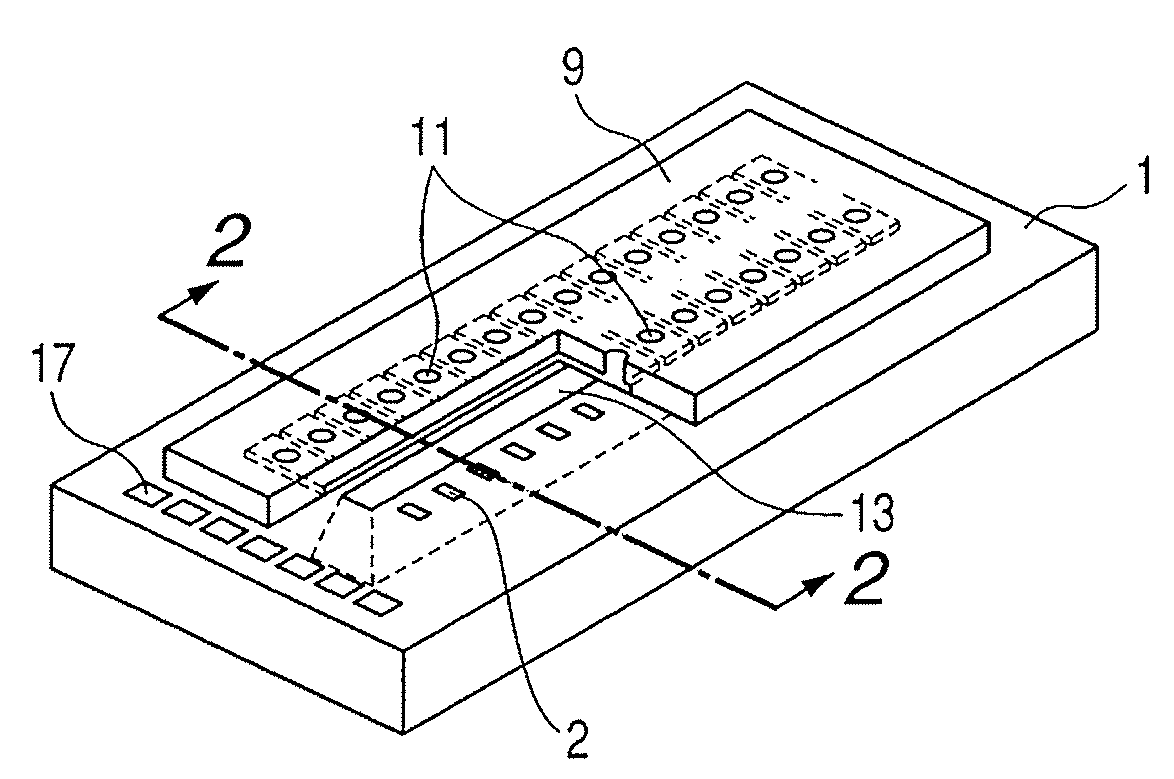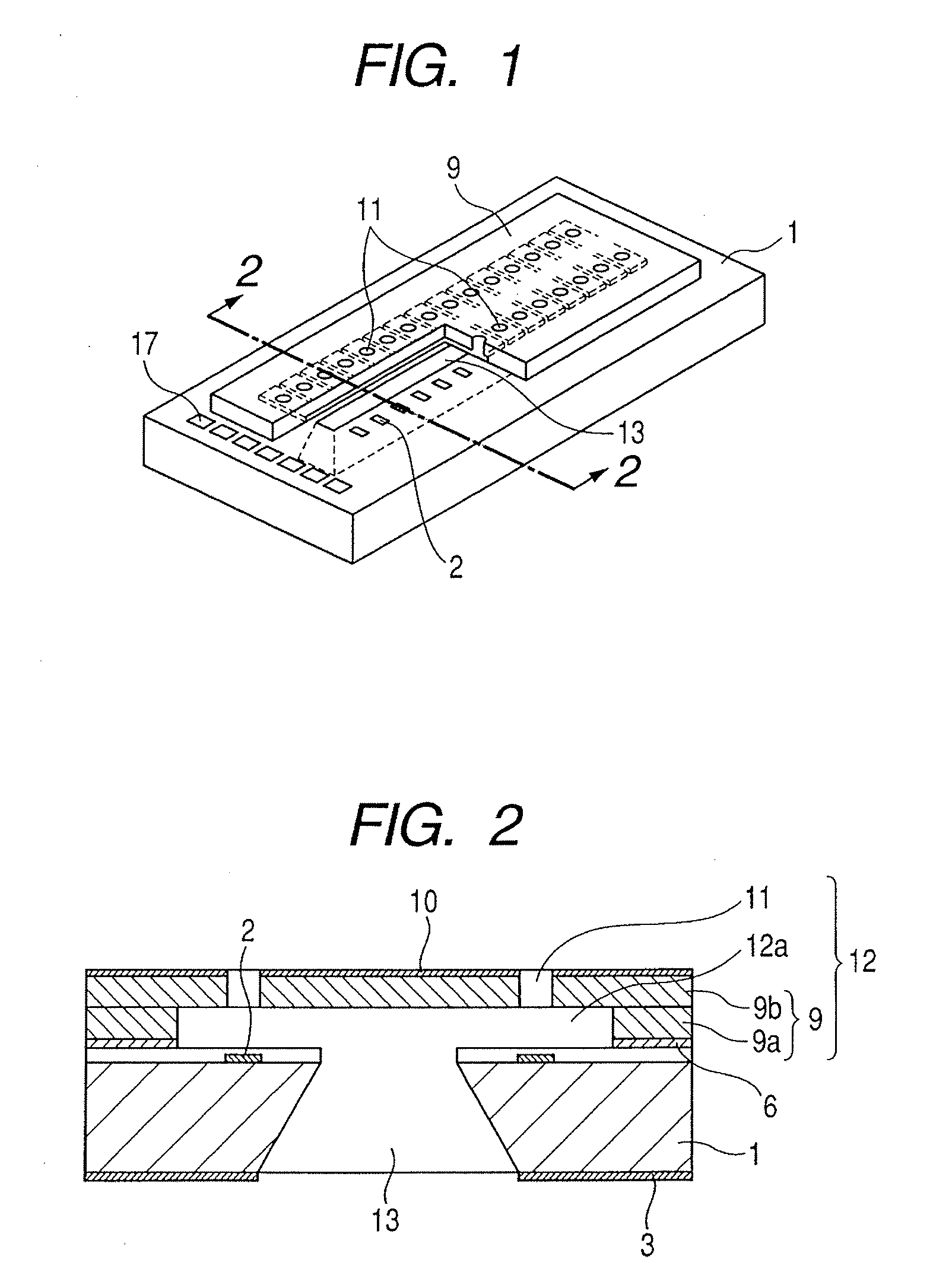Method of manufacturing ink jet recording head
- Summary
- Abstract
- Description
- Claims
- Application Information
AI Technical Summary
Benefits of technology
Problems solved by technology
Method used
Image
Examples
first embodiment
[0035]First, an adhesive material for forming the adhesive layers 6 on the substrate 1 equipped with the energy generating elements 2 is laminated (adhesive material lamination process).
[0036]First, a plurality of the energy generating elements 2 such as heating resistors or the like is formed in, for example, parallel two rows at the predetermined pitch, as described above, on the front surface of the substrate 1, which is made of silicon or the like, and the whole back surface of which is covered by a SiO2 film 3. Electrodes and wiring for supplying electric power to drive the energy generating elements 2 arranged in parallel two rows are connected to the energy generating elements 2. Moreover, a sacrifice layer 5 is formed between the energy generating elements 2. The sacrifice layer 5 is formed in order to suppress the increases of the errors of the calibers of the apertures on the upper side of the substrate 1, which errors are caused by the changes of the thickness of the subs...
second embodiment
[0051]As a second embodiment of the present invention, a case of using a photosensitive material as the adhesive layers 6 is described with reference to FIGS. 5A to 5C.
[0052]As shown in FIG. 5A, the adhesive material 6a to form the adhesive layers 6 is laminated on the protective film 4. Hereupon, usable materials as an adhesive material 6b are, for example, polyether amide, a crosslinking agent to crosslink the polyether amide under the existence of a catalyst such as an acid, and a photosensitive material to generate the catalyst by being exposed. To put it more concretely, there can be cited a melamine compound as the crosslinking agent, and a material known as a photoacid generator as the photosensitive material. Moreover, as the other examples of the adhesive material 6b, there can be cited a negative type photosensitive resin material containing the epoxy resin and the photoacid generator, and the like.
[0053]The polyether amide resin layers 7 to be the mask layers of the aniso...
third embodiment
[0058]A third embodiment of the present invention is described with reference to FIGS. 6A to 6D.
[0059]The present embodiment is an example of separating the process of forming the adhesive layers 6 and the process of forming the side walls 9a to increase the selectivity of the materials of both of them.
[0060]As shown in FIG. 6A, the adhesive material 6a to form the adhesive layers 6 is laminated on the protective film 4. As the adhesive material 6a, it is possible to use the adhesive materials described in the first and the second embodiments.
[0061]Next, as shown in FIG. 6B, the adhesive material 6a is patterned to form the adhesive layers 6. If the adhesive material 6a has photosensitivity, the patterning is performed by using the technique of photolithography. If the adhesive material 6a does not have the photosensitive, the patterning is performed by etching or the like.
[0062]Next, as shown inFIG. 6C, the flow path forming material 8 is laminated on the adhesive layers 6. As the ...
PUM
| Property | Measurement | Unit |
|---|---|---|
| Composition | aaaaa | aaaaa |
| Adhesivity | aaaaa | aaaaa |
| Energy | aaaaa | aaaaa |
Abstract
Description
Claims
Application Information
 Login to View More
Login to View More - R&D
- Intellectual Property
- Life Sciences
- Materials
- Tech Scout
- Unparalleled Data Quality
- Higher Quality Content
- 60% Fewer Hallucinations
Browse by: Latest US Patents, China's latest patents, Technical Efficacy Thesaurus, Application Domain, Technology Topic, Popular Technical Reports.
© 2025 PatSnap. All rights reserved.Legal|Privacy policy|Modern Slavery Act Transparency Statement|Sitemap|About US| Contact US: help@patsnap.com



